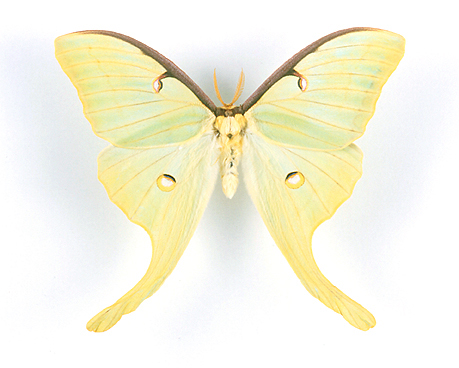American Luna Moth (Actias luna)
Pricing: Dead (spread, as pictured): $30-$40 , depending on quality and color (green coloration varies).
Geographic Range: Eastern North America
View: Top Sex: Male Size: Wingspan: 7.5-10.5cm

Image Copyright 2003
Barbara Strnadova
A nocturnal wonder, Actias luna is named after the Roman moon goddess Luna. It ranges from Nova Scotia west to Saskatchewan and eastern North Dakota, south to central Florida, the Gulf Coast, and eastern Texas. Specimens have also been captured in Mexico and the endemic species name of "Actias azteca" has been given to them (Packard, 1869). Once common in all temperate deciduous forests, Actias luna has disappeared from many urban centers due to habitat loss and the profusion of electric lights, which confuse the moths and lead them to their dooms. Attempts have been made to re-introduce them to New York City, so far with poor results (except on Staten Island). In the northern parts of its range there are one to two broods a year (depending on latitude); one on the wing late May-early July and the another in mid-August. In the south, there are two to three broods from March-September. Adults are short-lived. Having no digestive tract they have about ten days to mate before they die. Females lay eggs in small groups or singly on both surfaces of host plant leaves. Eggs hatch in 14-15 days and larvae mature in 30-55 days. Mature larvae are plump and green with a thin yellow stripe on their sides. They feed on many different trees; white birch (Betula papyrifera), persimmon (Diospyros virginiana), sweet gum (Liquidambar styraciflua,), alder (Alnus), beech (Fagus), oak (Quercus), cherry (Prunus), hickory (Carya), willow (Salix), walnut (Juglans), and many others. This varied diet makes the larvae vulnerable to insecticides sprayed indiscriminately. Also, the removal or burning of autumn leaves - which contain the cocoons - results in the destruction of many pupae, a great loss to places where the moth is uncommon. Our Luna moths are all captive bred. Live cocoons are available seasonally from July through April. Luna moths are fairly easy to rear and pairs will mate readily in captivity, even if they are siblings. In the southern parts of its range, the larvae prefer persimmon and sweet gum while larvae in the most northern latitudes show a preference for birch.